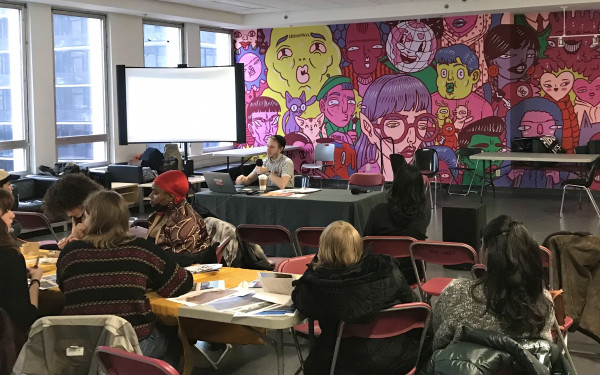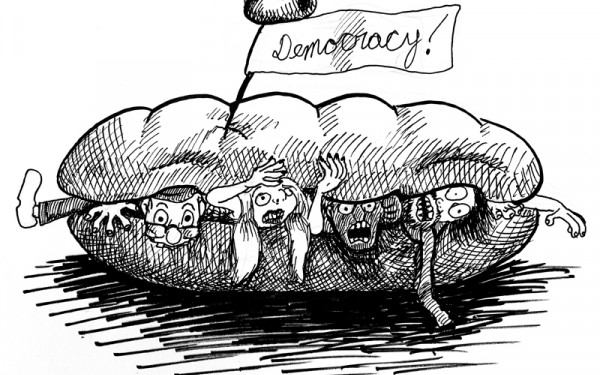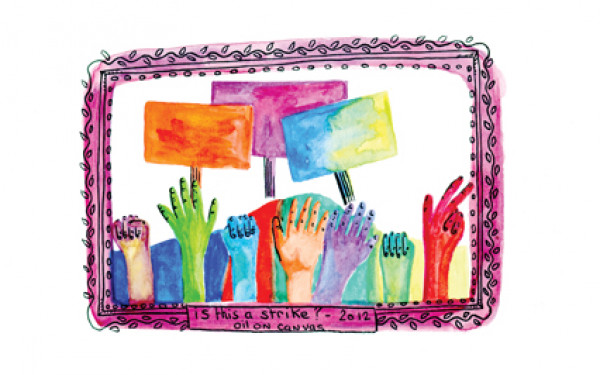Too Many Cooks Spoil the Assembly
Dawson Strike Vote Changed to Referendum After High Turnout
Dawson students are heading to polls once more to voice their opinion on the growing province-wide movement against proposed tuition hikes.
The Dawson Student Union held a Special General Assembly on March 1 where students were supposed to vote on whether or not to strike, but the meeting was adjourned before a consensus was reached due to a lack of space, and the show of hands was replaced by a referendum.
Voting opened on Monday and lasts until 9:00 p.m. on Tuesday.
Students can vote on if they’d be in support of a renewable one-week strike, a three-day strike, a one-day strike, or no strike at all.
With emotions running high at the CEGEP, allegations have arisen that the school interfered in the DSU’s organization of the vote by corresponding with the “no” committee directly.
Dawson Communications Manager Donna Varrica admitted to having contacted the “no” committee, but only because students had come to her with questions she could not answer.
“I had people in groups of three, four, five, six students—and parents too […] who were concerned that the people who wanted to vote “no” had no place to go get information,” she said.
“Our first reaction was to send them back to the student union, and that’s when [students] expressed their concerns that they didn’t feel that the ‘no’ side had a voice, and that led me to [send an] email asking [the ‘no’ committee] what was their plan of action.”
The “yes” and “no” committees were struck at the same time and the same number of representatives was elected for each. Both received the same budget of $150 for campaigning and are overseen by the Chief Electoral Officer Simon Cousineau.
Léo Fugazza, VP Internal Affairs & Advocacy said that, despite allowing personal involvement in the referendum from its members, the DSU as an institution has decided to remain impartial with regards to the strike referendum.
“That may be what [the DSU executives] felt,” said Varrica. “But it wasn’t the understanding of the students who came to see me. They felt that they were blatantly on the ‘yes’ side.”
Varrica said that school’s concerns with the way the DSU was organizing the vote were based on safety issues first, and respect for the democratic process second.
“It became clear to us early on that if there were more than 600 to 800 people present, there would be issues; that you needed to have a plan B, C, D—and we weren’t convinced that that was happening,” she said.
“[Based on] my knowledge of the school and its spaces, [I knew] that basically about 9,300 people would not be able to voice their opinion.”
The room where the SGA took place has a capacity of between 600 and 700 people, and while the gym fits 800 people, Varrica said it is usually booked for intramural sports.
Fugazza said the DSU asked the administration for rooms with higher capacities from the beginning, but were told all other rooms were booked.
“We looked into getting [other rooms], such as the amphitheatre and the gymnasium, which was always a no,” he said.
“When they realized that many, many, many people showed up, they agreed to give us [a second room]. We tried to set up a contingency room last minute and looked into getting the other rooms that were supposedly not available when we tried to book them—and then they were.”
The DSU is looking into having talks with the college to ensure that the school does not interfere in union matters in the future, Fugazza said, adding that students don’t resent the referendum form.
“It was just too crowded on Thursday and people were getting frustrated and tired,” he said. “It wasn’t a good situation to hold a vote on something as important as a strike.”
Vote count will start as soon as polls close on Tuesday at 9:00 p.m., and an official result will be published on Wednesday morning on facebook.com/mydsu.

2_700_651_90.jpg)
_700_933_90.jpg)
_600_832_s.png)



_600_375_90_s_c1.jpg)
